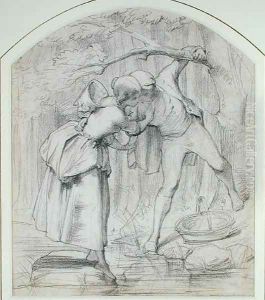John Richard Clayton Paintings
John Richard Clayton was an English artist born in 1827, renowned for his contributions to the field of stained glass design during the Victorian era. His work, characterized by its vibrant colors and intricate detailing, has been celebrated for breathing new life into the art of stained glass in England, a tradition that was experiencing a resurgence during the 19th century.
Clayton was educated at Rugby School before attending Trinity College, Cambridge, where he further developed his interest in art. His career in stained glass began when he joined forces with Alfred Bell, with whom he formed the firm Clayton & Bell in 1855. This partnership would go on to become one of the most prolific and respected stained glass workshops of the Victorian period. Their collaboration was marked by a shared vision that combined technical innovation with a deep respect for medieval stained glass traditions.
Under Clayton’s artistic direction, Clayton & Bell produced a vast array of stained glass windows for churches, cathedrals, and private homes throughout Britain and abroad. Their work is distinguished by the use of rich colors, achieved through the skilful application of enamels and the selection of high-quality glass, and by the incorporation of intricate narratives into their designs, often drawing upon biblical and historical themes.
Beyond stained glass, Clayton was also involved in other areas of decorative arts, including mosaic and mural painting, contributing to the broader aesthetic movement of his time, which sought to bring beauty and art into everyday life. His commitment to the revival of traditional crafts, combined with an innovative approach to design, made him a pivotal figure in the Victorian art world.
John Richard Clayton passed away in 1913, leaving behind a legacy that has continued to influence the art of stained glass making. Today, his work is preserved in numerous public and private collections, serving as a testament to his artistic vision and the enduring appeal of stained glass as a medium for artistic expression. His contribution to the Victorian era's artistic renaissance, particularly in the realm of stained glass, remains a significant chapter in the history of English art.
